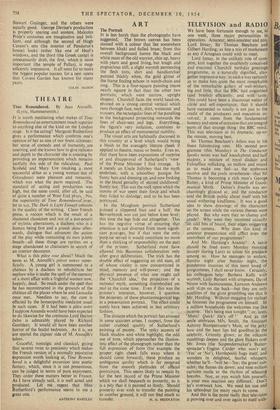ART
The Portrait IT is less harsh than the photographs have suggested. The brown canvas has been stained with a colour that lies somewhere between khaki and dulled brass; from this overall background looms the black and white mass of the old warrior, chin up, heavy with years and good living, but tough and pugnacious still, a slight warmth permeating the flesh tints, shirt and handkerchief painted 'thickly white, the gold glitter of
the frame finding echoes in watch-chain and ring. This is a four-square painting (more nearly square in fact than the other two portraits, which were narrow, upright shapes). Churchill faces the world head-on, pivoted on a strong central vertical which runs through face, neck, shirt, waistcoat and trousers, the rectangular lines of the panelling in the background projecting outwards the lines of chair-seat and legs. Everything, the figure's very isolation, combines to produce an effect of monumental stability.
The visual arts are habitually discussed in this country at a level which would bring a blush to the averagely literate cheek it' applied to theatre, music or books. Even so, that there have been expressions of surprise at and disapproval of Sutherland's 'view' of the Prime Minister I find strange. Is it merely an Uncle Jollyboy that the myth enshrines, with a schoolboy passion for funny hats and dressing up, and now 'basking in the bland geniality of second childhood? Surely not. This was the rock upon which the storms of war spent their force arid' which they failed to dislodge; and so he has been portrayed.
In the Maugham portrait 'Sutherland painted a slippered foot and a half; the Beaverbrook was cut just below knee level; this time the legs fade out altogether. This has the negative virtue of ensuring that attention is not diverted from more signifi- cant passages, but if that were the only purpase served it would constitute no more than a shirking of responsibility on the part
of the p.,inter. Sutherland must have allowed this Baconian collaboration only after great deliberation. The trick has the double effect of suggesting an old man, all of whose vitality is now concentrated in mind, memory and will-power; and the physical presence of what one might call the 'Churchill idea,' the projection of a national myth, something disembodied yet real at the same time. Even if this was the painter's intention, however, 1 question the propriety of these phantasmagorical legs in a presentation portrait. The effect could surely have been achieved in less arbitrary fashion.
The distaste which the portrait has aroused in some quarters arises, I suspect, from the .rather crabbed quality of Sutherland's painting of people. The spiky accents of black shadow and white highlight, the odd use of tone, which approaches the illusion- istic effect of the photograph rather than the full expression of form (for example the proper right cheek falls away where it should come forward), these produce an ambiguous quality which is far removed from the smooth platitudes of official portraiture. This seems likely to remain by far the best record of the Prime Minister which we shall bequeath to posterity, so it is a pity that it is painted so thinly. Should posterity ever wish to transfer the painting to another ground, it will not find much to








































 Previous page
Previous page